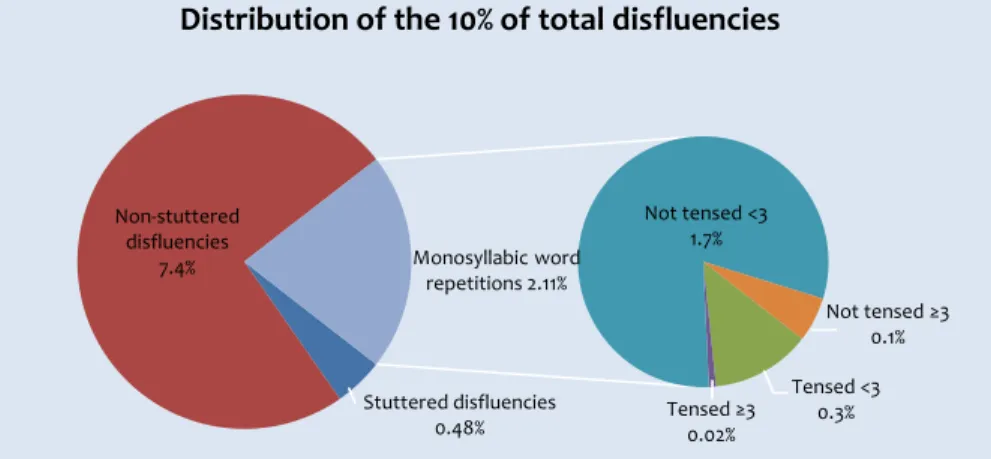Beyond stuttering
Speech disfluencies in normally fluent, French-speaking children at age four
A.L. Leclercq, P. Suaire, & A. Moyse - University of Liege, Belgium
16th International Clinical Phonetics and Linguistics Association. Halifax, Canada, June 15-18, 2016. Contact : al.leclercq@ulg.ac.be Stuttering diagnosis: 3% stuttered disfluencies (e.g., Boey et al., 2007; Yairi & Ambrose, 2005).
Monosyllabic word repetitionsare the prime characteristics that prompt identification of early stuttering by parents (Yairi & Ambrose, 2013). But should all monosyllabic word repetitions be considered as stuttered disfluencies, given their high frequency in typically developing young children (Howell, 2013; Wingate, 2001; Yairi et al., 2001)?
Few normative data existconcerning the disfluencies occurring in the speech of normally fluent children (Tumanova et al., 2014) and none exist in French.
Speech samples
- More than 200-word conversational speech sample, based on utterances longer than two words (Boey et al., 2007)
- Speech samples were videotaped for latter transcription (Howell et al., 2011)
Participants
- 66 monolingual, French-speaking children who do not stutter, aged 4 (40 boys)
- They exhibited less than three stuttered disfluencies per 100 words of conversational speech, and scored ≤ 10 on the SSI-IV (Riley, 2009) - Absence of labelling of stuttering now or in the past by family members and a specialised SLP
Methods Introduction
Table 1. Descriptive statistics for non-stuttered disfluencies, stuttered disfluencies, monosyllabic whole word repetitions
and total disfluencies per 100 words.
Monosyllabic whole word repetitions were coded as being tensed or not tensed (i.e. repeated fast), and repeated less than three times or three times and more (Ambrose & Yairi, 1995; Throneburg & Yairi, 1994).
Results Non-stuttered disfluencies Stuttered disfluencies Monosyllabic word repetitions Total disfluencies Mean (SD) 7.42 (2.88) 0.48 (0.50) 2.11 (1.68) 10.02 (4.27) Range 3.44 – 15.96 0 – 2.09 0.22 – 7.09 3.81 – 23.4 Multisyllabic word repetitions 0.2% Interjections 3.7% Phrase repetitions 1.3% Revisions 2.2%
Non-stuttered disfluencies: 7.42%
Stuttered disfluencies 0.48% Non-stuttered disfluencies 7.4% Tensed <3 0.3% Tensed ≥3 0.02% Not tensed <3 1.7% Not tensed ≥3 0.1% Monosyllabic word repetitions 2.11%Distribution of the 10% of total disfluencies
Part word repetitions 0.38% Sound prolongations 0.06% Blocks 0.08%
Stuttered disfluencies: 0.48%
The average of total disfluencies observed in normally fluent children aged 4 was 10 per 100 words. As expected, stuttered disfluencies (i.e. part-word repetitions, sound prolongations and blocks) occur less frequently than 3 in 100 words, ranging from 0 to 2.09%.
The frequency ofnon-stuttered disfluencies (7.42%)was slightly higher than previously observed in other languages (from 1.5 to 5.4 %; Johnson et al., 1959; Pellowski & Conture, 2002; Tumanova et al., 2014; Yairi & Ambrose, 2005), probably because we calculated the disfluencies from sentences longer than two words, and from an off-line procedure (Yaruss, 1997). There was a high variability among children: 3.44 to 15.96% non-stuttered disfluencies.
Discussion
The aim of the present study is to establish
normative data concerning the speech disfluencies
existing in normally fluent, French-speaking children
at age 4, an age at which stuttering onset has occurred
in 95% of children who stutter (Yairi & Ambrose, 2013).
Aim
The frequency of monosyllabic word repetitions is around 2%, with a high variability among children (ranging from 0.22 to 7.09%), butmost (1.7%) are repeated less than three times and are not tensed. This corroborates previous result that for non-stuttering children, repetitive disfluency usually have one iteration (Natke et al., 2006).
Our results support theneed to be careful when considering monosyllabic word repetitions as stuttered disfluencies: when incorporating all kinds of monosyllabic whole word repetitions into stuttered disfluencies, 15 of the 66 children could be considered as producing ≥3% ‘stuttered’ disfluencies. Two criteria should be taken into account when deciding whether or not a monosyllabic word repetition is stuttered in young children: the tension and the number (three or more) of repetitions – corroborating previous data in English (Ambrose & Yairi, 1995; Throneburg & Yairi, 1994).
